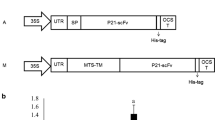Abstract
Tomato yellow leaf curl virus (TYLCV) is a geminivirus species whose members cause severe crop losses in the tropics and subtropics. We report the expression of a single-chain variable fragment (scFv) antibody that protected Nicotiana benthamiana plants from a prevalent Iranian isolate of the virus (TYLCV-Ir). Two recombinant antibodies (scFv-ScRep1 and scFv-ScRep2) interacting with the multifunctional replication initiator protein (Rep) were obtained from phage display libraries and expressed in plants, both as stand-alone proteins and as N-terminal GFP fusions. Initial results indicated that both scFvs and both fusions accumulated to a detectable level in the cytosol and nucleus of plant cells. Transgenic plants challenged with TYLCV-Ir showed that the scFv-ScRep1, but more so the fusion proteins, were able to suppress TYLCV-Ir replication. These results show that expression of a scFv-ScRep1-GFP fusion protein can attenuate viral DNA replication and prevent the development of disease symptoms. The present article describes the first successful application of a recombinant antibody-mediated resistance approach against a plant DNA virus.









Similar content being viewed by others
References
Moriones E, Navas-Castillo J (2000) Tomato yellow leaf curl virus, an emerging virus complex causing epidemics worldwide. Virus Res 71:123–134
Czosnek H, Laterrot H (1997) A worldwide survey of tomato yellow leaf curl viruses. Arch Virol 142:1391–1406
Nakhla MK, Maxwell DP (1998) Epidemiology and management of tomato yellow leaf curl disease. In: Hadidi A, Khetarpal RK, Koganezawa H (eds) Plant virus disease control. APS Press, Saint Paul, pp 565–583
Mansoor S, Briddon RW, Zafar Y, Stanley J (2003) Geminivirus disease complexes: an emerging threat. Trends Plant Sci 8:128–134
Zakay Y, Navot N, Zeidan M, Kedar N, Rabinowitch H, Czosnek H, Zamir D (1990) Screening of Lycopersicon accessions for resistance to Tomato leaf curl virus: presence of viral DNA and symptom development. Plant Dis 75:279–281
Kunik T, Salomon R, Zamir D, Navot N, Zeidan M, Michelson I, Gafni Y, Czosnek H (1994) Transgenic tomato plants expressing the Tomato yellow leaf curl virus capsid protein are resistant to the virus. Biotechnology NY 12:500–504
Noris E, Accotto GP, Tavazza R, Brunetti A, Crespi S, Tavazza M (1996) Resistance to tomato yellow leaf curl geminivirus in Nicotiana benthamiana plants transformed with a truncated viral C1 gene. Virology 224:130–138
Brunetti A, Tavazza M, Noris E, Tavazza R, Caciagli P, Ancora G, Crespi S, Accotto GP (1997) High expression of truncated viral Rep protein confers resistance to Tomato yellow leaf curl virus in transgenic tomato plants. Mol Plant Microbe Interact 10:571–579
Hou YM, Sanders R, Ursin VM, Gilbertson RL (2000) Transgenic plants expressing geminivirus movement proteins: abnormal phenotypes and delayed infection by Tomato mottle virus in transgenic tomatoes expressing the Bean dwarf mosaic virus BV1 or BC1 proteins. Mol Plant Microbe Interact 13:297–308
Von Arnim A, Stanley J (1992) Inhibition of African cassava mosaic virus systemic infection by a movement protein from the related geminivirus Tomato golden mosaic virus. Virology 187:555–564
Bendahmane M, Gronenborn B (1997) Engineering resistance against Tomato yellow leaf curl virus (TYLCV) using antisense RNA. Plant Mol Biol 33:351–357
Zrachya A, Kumar PP, Ramakrishnan U, Levy Y, Loyter A, Arazi T, Lapidot M, Gafni Y (2007) Production of siRNA targeted against TYLCV coat protein transcripts leads to silencing of its expression and resistance to the virus. Transgenic Res 16:385–398
Stanley J, Frischmuth T, Ellwood S (1990) Defective viral DNA ameliorates symptoms of geminivirus infection in transgenic plants. Proc Natl Acad Sci USA 87:6291–6295
Fuentes A, Ramos PL, Fiallo E, Callard D, Sanchez Y, Peral R, Rodriguez R, Pujol M (2006) Intron-hairpin RNA derived from replication associated protein C1 gene confers immunity to Tomato yellow leaf curl virus infection in transgenic tomato plants. Transgenic Res 15:291–304
Schillberg S, Zimmermann S, Zhang MY, Fischer R (2001) Antibody-based resistance to plant pathogens. Transgenic Res 10:1–12
Nagy PD, Simon AE (1997) New insights into the mechanisms of RNA recombination. Virology 235:1–9
Rubio T, Borja M, Scholthof HB, Jackson AO (1999) Recombination with host transgenes and effects on virus evolution: an overview and opinion. Mol Plant Microbe Interact 12:87–92
Masuta C, Ueda S, Suzuki M, Uyeda I (1998) Evolution of a quadripartite hybrid virus by inter specific exchange and recombination between replicase components of two related tripartite RNA viruses. Proc Natl Acad Sci USA 95:10487–10492
Tavladoraki P, Benvenuto E, Trinca S, De Martinis D, Cattaneo A, Galeffi P (1993) Transgenic plants expressing a functional single-chain Fv antibody are specifically protected from virus attack. Nature 366:469–472
Zimmermann S, Schilberg S, Yu-Cai L, Fischer R (1998) Intracellular expression of TMV-specific single-chain Fv fragments leads to improved virus resistance in Nicotiana tabacum. Mol Breed 4:369–379
Xiao WX, Chu PWG, Frenkel MG, Tabe LM, Shukla DD, Hanna PJ, Higgins TJV, Muüller WJ, Ward CW (2000) Antibody-mediated improved resistance to CIYVV and PVY infections in transgenic tobacco plants expressing a single-chain variable region antibody. Mol Breed 6:421–431
Voss A, Niersbach M, Hain R, Hirsch H, Liao Y, Kreuzaler F, Fischer R (1995) Reduced virus infectivity in N. tabacum secreting a TMV-specific full size antibody. Mol Breed 1:39–50
Schillberg S, Zimmermann S, Findlay K, Fischer R (2000) Plasma membrane display of anti-viral single chain Fv fragments confers resistance to tobacco mosaic virus. Mol Breed 6:317–326
Fecker LF, Koenig R, Obermeier C (1997) Nicotiana benthamiana plants expressing beet necrotic yellow vein virus (BNYVV) coat protein-specific scFv are partially protected against the establishment of the virus in the early stages of infection and its pathogenic effects in the late stages of infection. Arch Virol 142:1857–1863
Boonrod K, Galetzka D, Nagy PD, Conrad U, Krczal G (2004) Single-chain antibodies against a plant viral RNA-dependent RNA polymerase confer virus resistance. Nat Biotechnol 22:856–862
Orozco PM, Kong LJ, Batts LA, Elledge S, Hanley-Bowdoin L (2000) The multifunctional character of a geminivirus replication protein is reflected by its complex oligomerization properties. J Biol Chem 275:6114–6122
Konz C, Schell J (1986) The promoter of TL-DNA gene 5 controls the tissue-specific expression of chimaeric genes carried by a novel type of Agrobacterium binary vector. Mol Gen Genet 204:382–396
Safarnejad MR, Fischer R, Commandeur U (2008) Generation and characterization of functional recombinant antibody fragments against Tomato yellow leaf curl virus replication-associated protein. Comm Agric Appl Biol Sci 73:311–323
Horsch RB, Rogers SG, Fraley RT (1985) Transgenic plants. Cold Spring Harb Symp Quant Biol 50:433–437
Stenger DC, Revington GN, Stevenson MC, Bisaro DM (1991) Replicational release of geminivirus genomes from tandemly repeated copies: evidence for rolling-circle replication of a plant viral DNA. Proc Natl Acad Sci USA 88:8029–8033
Fecker LF, Kaufmann A, Commandeur U, Commandeur J, Koenig R, Burgermeister W (1996) Expression of single-chain antibody fragments (scFv) specific for Beet necrotic yellow vein virus coat protein or 25 kDa protein in Escherichia coli and Nicotiana benthamiana. Plant Mol Biol 32:979–986
Vanderschuren H, Stupak M, Futterer J, Gruissem W, Zhang P (2007) Engineering resistance to geminiviruses: review and perspectives. Plant Biotechnol J 5:207–220
Lu M, Gong XG, Yu H, Li JY (2005) Cloning, expression, purification, and characterization of LC-1 ScFv with GFP tag. J Zhejiang Univ Sci B 6:832–837
Hink MA, Griep RA, Borst JW, van Hoek A, Eppink MH, Schots A, Visser AJ (2000) Structural dynamics of green fluorescent protein alone and fused with a single chain Fv protein. J Biol Chem 275:17556–17560
Casey JL, Coley AM, Tilley LM, Foley M (2000) Green fluorescent antibodies: novel in vitro tools. Protein Eng 13:445–452
Zeytun A, Jeromin A, Scalettar BA, Waldo GS, Bradbury AR (2003) Fluorobodies combine GFP fluorescence with the binding characteristics of antibodies. Nat Biotechnol 21:1473–1479
Schwalbach G, Sibler AP, Choulier L, Deryckere F, Weiss E (2000) Production of fluorescent single-chain antibody fragments in Escherichia coli. Protein Expr Purif 18:121–132
Peipp M, Saul D, Barbin K, Bruenke J, Zunino SJ, Niederweis M, Fey GH (2004) Efficient eukaryotic expression of fluorescent scFv fusion proteins directed against CD antigens for FACS applications. J Immunol Methods 285:265–280
De Jaeger G, Buys E, Eeckhout D, De Wilde C, Jacobs A, Kapila J, Angenon G, Van Montagu M, Gerats T, Depicker A (1999) High level accumulation of single-chain variable fragments in the cytosol of transgenic Petunia hybrida. Eur J Biochem 259:426–434
Frisch C, Kolmar H, Schmidt A, Kleemann G, Reinhardt A, Pohl E, Uson I, Schneider TR, Fritz HJ (1996) Contribution of the intra-molecular disulfide bridge to the folding stability of REIv, the variable domain of a human immunoglobulin kappa light chain. Fold Des 1:431–440
Ewert S, Huber T, Honegger A, Pluckthun A (2003) Biophysical properties of human antibody variable domains. J Mol Biol 325:531–553
Worn A, Pluckthun A (2001) Stability engineering of antibody single-chain Fv fragments. J Mol Biol 305:989–1010
De Jaeger G, De Wilde C, Eeckhout D, Fiers E, Depicker A (2000) The plantibody approach: expression of antibody genes in plants to modulate plant metabolism or to obtain pathogen resistance. Plant Mol Biol 43:419–428
Prins M, Lohuis D, Schots A, Goldbach R (2005) Phage display-selected single-chain antibodies confer high levels of resistance against Tomato spotted wilt virus. J Gen Virol 86:2107–2113
Glockshuber R, Schmidt T, Pluckthun A (1992) The disulfide bonds in antibody variable domains: effects on stability, folding in vitro, and functional expression in Escherichia coli. Biochemistry 31:1270–1279
Rudikoff S, Pumphrey JG (1986) Functional antibody lacking a variable-region disulfide bridge. Proc Natl Acad Sci USA 83:7875–7878
Proba K, Honegger A, Pluckthun A (1997) A natural antibody missing a cysteine in VH: consequences for thermodynamic stability and folding. J Mol Biol 265:161–172
Lombardi A, Sperandei CantaleC, Giacomini P, Galeffi P (2005) Functional expression of a single-chain antibody specific for the HER2 human oncogene in a bacterial reducing environment. Protein Exp Purif 44:10–15
Kheyr-Pour A, Gronenborn B, Czonek H (1994) Agroinoculation of Tomato yellow leaf curl virus (TYLCV) overcomes the virus resistance of wild Lycopersicon species. Plant Breeding 112:228–233
Bananej K, Kheyr-Pour A, Salekdeh GH, Ahoonmanesh A (2004) Complete nucleotide sequence of Iranian Tomato yellow leaf curl virus isolate: further evidence for natural recombination amongst begomoviruses. Arch Virol 149:1435–1443
Shivaprasad PV, Thillaichidambaram P, Balaji V, Veluthambi K (2006) Expression of full-length and truncated Rep genes from Mungbean yellow mosaic virus-Vigna inhibits viral replication in transgenic tobacco. Virus Genes 33:365–374
Abhary MK, Anfoka GH, Nakhla MK, Maxwell DP (2006) Post-transcriptional gene silencing in controlling viruses of the Tomato yellow leaf curl virus complex. Arch Virol 151:2349–2363
Neuhuber F, Park YD, Matzke AJ, Matzke MA (1994) Susceptibility of transgene loci to homology-dependent gene silencing. Mol Gen 244:230–241
Biocca S, Ruberti F, Tafani M, Pierandrei-Amaldi P, Cattaneo A (1995) Redox state of single chain Fv fragments targeted to the endoplasmic reticulum, cytosol and mitochondria. Biotechnology NY 13:1110–1115
Jupin I, Hericourt F, Benz B, Gronenborn B (1995) DNA replication specificity of TYLCV geminivirus is mediated by the amino-terminal 116 amino acids of the Rep protein. FEBS Lett 362:116–120
Laufs J, Schumacher S, Geisler N, Jupin I, Gronenborn B (1995) Identification of the nicking tyrosine of geminivirus Rep protein. FEBS Lett 377:258–262
Desbiez C, David C, Mettouchi A, Laufs J, Gronenborn B (1995) Rep protein of tomato yellow leaf curl geminivirus has an ATPase activity required for viral DNA replication. Proc Natl Acad Sci USA 92:4–5640
Acknowledgments
We would like to thank Dr. Thomas Rademacher (Institute of Molecular Biotechnology, RWTH Aachen University) for his help with fluorescence microscopy and the preparation of plant expression vectors. We acknowledge Prof. Dr. Bruno Gronenborn (Institut des Sciences du Vegetal, CNRS, Gif-sur-Yvette, France) for his useful advice and support while the work was in progress. We thank Dr. Richard Twyman for his critical reading and helpful comments on the preparation of this paper.
Author information
Authors and Affiliations
Corresponding author
Rights and permissions
About this article
Cite this article
Safarnejad, M.R., Fischer, R. & Commandeur, U. Recombinant-antibody-mediated resistance against Tomato yellow leaf curl virus in Nicotiana benthamiana . Arch Virol 154, 457–467 (2009). https://doi.org/10.1007/s00705-009-0330-z
Received:
Accepted:
Published:
Issue Date:
DOI: https://doi.org/10.1007/s00705-009-0330-z




